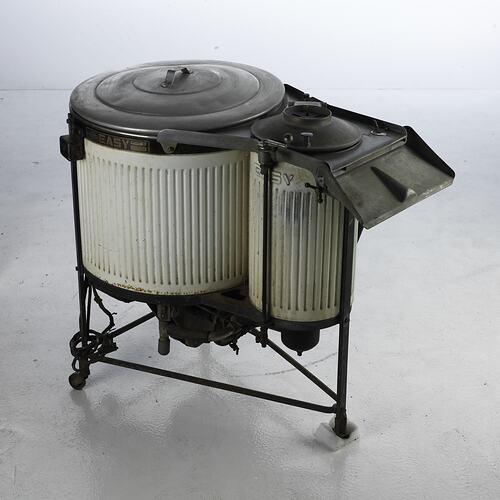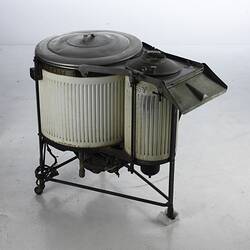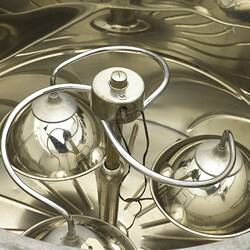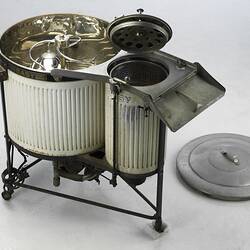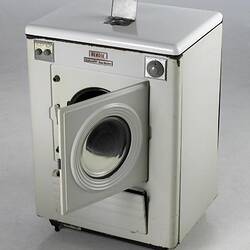Summary
Electric 32 volt washing machine manufactured by Syracuse Washing Machine Corporation in New York, United States of America, circa 1920s. The manufacturer who made the washing machine was originally formed in 1877 as Dodge & Zuill. The name Syracuse Washing Machine Corporation was used 1919-1932, after which the business became the Easy Washing Machine Corporation.
This twin tub model, named the 'Easy', was made throughout the 1920s and 1930s, but was originally patented in 1912. It was the basis of the later standard twin-tub washing machine, and at the time represented a major advance in washing-machine design. The machine is made from enamelled metal and stainless steel, and features two tubs set in a triangular frame. It has rinse and spin dry options, with settings marked 'blue', 'suds' and 'rinse'. The larger tub is the agitator tub and the smaller tub acted to rinse and spin the clothes. The washing machine stands 98.2 cm high, is 104.4 cm in length and 62.0 cm wide. The Syracuse 'Easy' featured vacuum-cup technology, which helped force soapy water through clothes.
The very name of this washing machine reinforced the alluring, but not entirely true, promise from advertisers that electrical appliances would be labour saving. Although it offered some advantages, unlike modern washing machines this machine was not automatic and still required much manual handling of the washing.
This domestic machine would have been operated almost exclusively by women, as washing was regarded as 'women's work' during the 19th century and most of the 20th century. While these attitudes were challenged by the women's liberation movement of the 1970s, studies in the early 21st century have found that men still do not participate equally in household chores.
Physical Description
Model 'R'. Metal is not enamelled. Has vacuum cup agitator system.
More Information
-
Collecting Areas
-
Acquisition Information
Donation
-
Manufacturer
Syracuse Washing Machine Corporation, New York, New York State, United States of America, circa 1935
In 1932 the company's name was changed to the Easy Washing Machine Corporation, so the machine must date prior to 1932. -
Inscriptions
Label on side of main drum: SYRACUSE / WASHING MACHINE / CORPORATION ...' Has settings and openings marked 'Blue', 'Suds' and 'Rinse'. Serial no. 267234. Number printed on Frame: 108309. Number printed on Wringer: 10223.
-
Model Name or Number
-
Brand Names
-
Classification
-
Category
-
Discipline
-
Type of item
-
Exhibition Collection Management
990 mm (Length), 1000 mm (Width), 720 mm (Height)
-
References
'Easy Washing Machine Co,' Gas Engine Magazine, with content from Onondaga Historical Association in Syracuse, New York, [Link 1] accessed 12 May 2019. Syracuse Washing Machine Corporation, named in summary of the Smithsonian National Museum of American History's Warshaw Collection of Business Americana, [Link 2] accessed 12 May 2019. HarryRinker.com, [Link 3] accessed 12 May 2019. MyCompaniesWiki, [Link 4] accessed 12 May 2019.
-
Keywords
